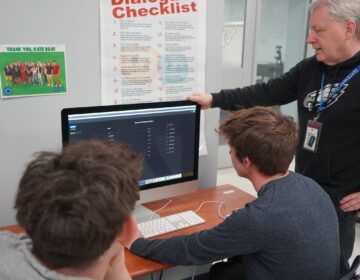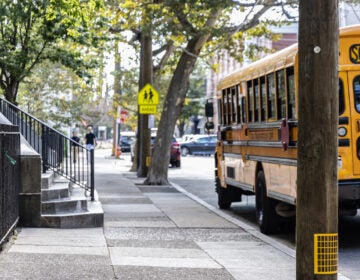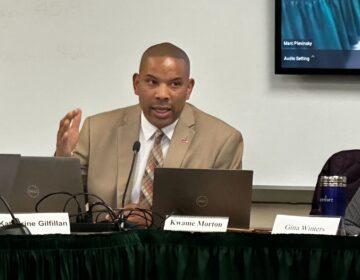Temple prof: Pa. cyber charters turning huge profits, sending tax dollars out of state
ListenFewer teachers. No school building. No heating bill. Same cost.
You’d think Pennsylvania’s 16 cyber-charter schools, which teach home-based students via the Web, would spend a lot less per student than bricks and mortar schools.
Not so.
They collect as much money per student as the state’s brick-and-mortar charter schools. Despite a call from Governor Tom Corbett to do otherwise, the state still doesn’t ask how much it actually costs to educate students in cyber-charters to proficiency standards (nor does it, actually, for any of its schools).
Instead — as it does for brick-and-mortar charters — the state simply demands that school districts turn 70 percent to 80 percent of their normal per-pupil costs over to the cybers. (School districts are allowed to deduct certain expenses such as debt-service and transportation costs from their payments to charter schools.)
Those costs, of course, differ greatly from one school district to another. And since the state’s cyber charters can take students from any of Pennsylvania’s 500 school districts, they receive wildly different funding rates depending on a student’s home base.
If a regular-education student from Lower Merion school district attended a cyber-charter in 2011-2012, Lower Merion (which then had a per-pupil expenditure of $22,140.70) sent the cyber charter about $17,000.
If a regular-education student from the Philadelphia school district attended the same cyber-charter, Philadelphia (which then had a per-pupil expenditure of $12,351.74) sent the cyber charter about $8,500.
Same cyber school. Same cyber-education. Outrageously different price tag.
Tax forms
So how exactly are the state’s cyber charters using this money?
That’s the question Temple law professor Susan DeJarnatt set to answer in an article recently published in Urban Lawyer.
Parsing the tax documents for the 12 cyber charters for which information was available, she found that cyber charters carry large surpluses and spend what she considered a disproportionate amount of Pennsylvania tax dollars on advertising, travel expenses and contracts with outside management and service providers.
In her analysis, DeJarnatt breaks down cyber-charters into two categories.
Four of the twelve cyber charters were set up by the regional consortiums of public school districts called Intermediate Units (IUs). These are: 21st Century, Central PA Digital Learning Foundation, PA Learners Online Regional Cyber Charter, and SusQ-Cyber Charter.
The remaining “independent” cybers, DeJarnatt writes, “have no direct connection to any public school district.” She calls five of these “mega-cybers” because they “enroll the largest number of students and tend to employ outside managers.” She counts as “mega-cybers”: Agora Cyber, Commonwealth Connections Academy, PA Cyber, PA Leadership Charter, and PA Virtual.
These schools, she writes, “tend to carry significant surpluses and have accumulated significant assets.”
Surpluses
The 10 cybers with publicly available tax forms maintained a total surplus of $13,688,029 and held net assets of $35,900,476.
One IU-run cyber (PA Learners Online Regional) and one independently-run cyber (PA Cyber) did not have publicly available tax-forms.
Maintaining some sort of surplus is common in all public schools. State law requires Pennsylvania school districts to keep at least 5 percent of their annual spending in undesignated reserve funds to preserve bond ratings. According to data from the Pennsylvania Department of Education, as a whole, Pennsylvania’s public schools have amassed $3.8 billion in surpluses.
“It’s fiscally responsible for public schools to set aside funds for emergency purposes and unexpected expenditures,” said PDE spokesman Tim Eller. “However, the proper amount of a surplus is debatable.”
Follow the money
Comparing IU-run cybers with independently run cybers, DeJarnatt points out the stark disparities for expenses such as advertising, travel and management fees.
Analyzing 2009 and 2010 tax forms, DeJarnatt found that the three IU-run cybers for which data were available spent $397,031 on such expenses.
The seven independent schools for which data were available spent $54,464,226.
By paying such fees, DeJarnatt points out that independent cybers often send a windfall of Pennsylvania taxpayer dollars out of state.
She cites PA Cyber as a case in point.
PA Cyber, the nation’s largest, is managed by a national non-profit organization of its own creation–the National Network of Digital Schools (NNDS). DeJarnatt found that PA Cyber “pays” NNDS over $30,000,000 annually for the rights to curricula that PA Cyber itself originally developed.
NNDS then can use those Pennsylvania taxpayer funds to complete its mission of providing “curriculum and management support to cyber schools across the country.”
PA Cyber disputes DeJarnatt’s characterization here, saying that “NNDS bought an infantile version of [the curriculum] from PA Cyber and invested into developing it into a robust, fully accredited, standards-based curriculum, which now features over 250 courses.”
DeJarnatt says there hasn’t been enough oversight to check if taxpayers are actually getting value for their money. “Somebody needs to look at it,” she said. “That’s my bottom line.”
DeJarnatt also spotlights Agora Cyber.
Agora has a management contract with the national for-profit K-12 Inc. DeJarnatt found that Agora paid K-12 Inc. $14,967,243 in 2010.
“So a significant portion of the taxpayer money that goes to Agora to fund the education of the students at Agora is itself turned over to for-profit managers,” said DeJarnatt. “There’s nothing inherently illegal or wrong about that as long as the school is actually getting value for the money, but it’s a question for me.”
With so much money flowing to cybers, DeJarnatt says the “situation is ripe for potential abuse.”
“Cyber schools are…more vulnerable to exploitation by self-interested individuals because the parent community is geographically dispersed and less able to easily meet to address concerns; the local school boards have no oversight authority; and the Pennsylvania Department of Education has not exhibited much concern about potential abuses,” DeJarnatt wrote in the article.
PA Cyber Charter founder Nick Trombetta faces federal charges for allegedly siphoning more than $8 million from the school for personal benefit through a network of other profit and non-profit companies he controlled.
Of Trombetta’s actions, United States Attorney David Hickton stated: “We allege this was a conscious, intentional scheme to steal money that was to be used to educate our children.”
Agora Cyber Charter founder Dorothy June Brown is currently facing federal charges for allegedly defrauding four charter schools that she founded of $6.7 million. (Jury deliberations in Brown’s case resumed today.)
DeJarnatt says these alleged abuses aren’t necessarily the result of a lack of disclosure, but instead, a lack of resources devoted to oversight.
“There is ample disclosure in the form of annual reports to the Pennsylvania Department of Education, informational tax returns to the IRS, and occasional audits by the Auditor General,” DeJarnatt writes.
“However, no agency is sufficiently staffed or funded to provide effective examination of the disclosures and to address the problems that the disclosures may raise.”
Performance
Funding levels could be justified, critics of cybers say, if the schools evidenced great gains in student achievement.
A recent brief by the non-profit Research for Action found that for the 11 cyber charters that the state rated in its School Performance Profile evaluations, all scored among the lowest performers in the state.
No cyber charter with SPP scores attained the state average.
The study also found that the state’s cyber-charters had high rates of student churn. The five cyber charter schools with enrollment data had higher average transfer-in and transfer-out rates than all brick-and-mortar charters with available data.
“It’s troubling to think that entities with such poor outcomes are spending all these resources on self-promotion rather than on improving their services,” said Education Law Center staff attorney David Lapp.
Lapp says DeJarnatt’s study is “one more reason why Pennsylvania would be wise to institute a moratorium on cyber charter expansion until we see actual results.”
The state granted four cyber charters for 2012-2013 school year.
The state rejected all eight that applied for 2013-2014 school year.
For the 2014-2015 school year, the state has heard another six applications. It will make its decision by the end of January.
In response to demand for cyber options, the Philadelphia School District opened its own virtual school at the beginning of this school year called the Philadelphia Virtual Academy. When Philadelphia students choose to attend PVA instead of one of the state’s 16 cyber-charter options, the district estimates it saves 45-percent.
It costs the district $5,700 to educate students virtually, savings of over $4,000 per pupil compared to its own brick-and-mortar education.
One-percent
Proponents of cyber education say DeJarnatt’s article is “an all too familiar one-sided look at cyber education.”
Jennifer Bradmon, executive director of PA Families for Public Cyber Schools, says the conversation about cyber-charter funding must be put into perspective.
“In Pennsylvania, cyber education accounts for less than 1-percent of the billions of dollars spent by Pennsylvania every year on public education,” said Bradmon. “Nobody ever seems to look at that number, yet school districts use cybers as an excuse to raise taxes.”
Bradmon also points out that most schools in some way contract with for-profit service providers.
“Are text books free for traditional school districts? How about desks? What about pencils?” she asked. “School districts spend billions on for-profit outside consultants and companies every year.”
As far as advertising, Bradmon says cybers should be free to use taxpayer dollars in whatever way they deem most effective.
“I can tell you firsthand that my family did not know about public cyber schools until we heard an advertisement on the radio,” Bradmon wrote. “Thank goodness we did. Cybers have been the best thing to happen to our daughters.”
Instead of targeting the funding of cyber-charters, Bradmon says advocates should focus on fixing Pennsylvania’s education funding system as a whole.
Tom Schaaf, school outreach communicator for the cyber-school Commonwealth Connections Academy, argues that cybers need to build up revenue surpluses to ensure financial stability.
Because they must renew their charters every five years, Schaaf says cybers have a difficult time borrowing capital.
“No one wants to lend to someone who’s charter only exists for 5 years,” he said.
Schaaf says Commonwealth Connections Academy spends about $9,500 per pupil.
“If we come up with more money than we anticipated, than great,” Schaaf said, “we can use that money to better serve our families.”
Pending legislation
Robert Fayfich, executive director of the Pennsylvania Coalition for Public Charter Schools, agrees that cyber charters are too often picked on.
Although he says it seems “logical” to look at the numbers and conclude that cybers are overpaid, “when you look at the detail of it, there’s costs that the cyber schools have that the brick-and-mortars do not have that may offset that differential, and may not.”
Cyber-charters must provide students with computers and internet access, must rent facilities for students to take standardized tests, and must budget for the multitude of expenses that come with educating a state-wide network of students.
But Fayfich agrees with DeJarnatt that “no one’s done a good analysis” of how much it actually costs to educate students virtually.
A piece of pending legislation in Harrisburg, Senate Bill 1085, would set up a commission to do just that. (It would also cut cyber charter funding across the board by an arbitrary 5 percent.)
The legislation, known commonly as the charter-reform bill, would also provide more oversight, transparency and accountability for charter schools across the state–provisions that charter-advocates like Fayfich and traditional-public-education advocates like DeJarnatt both agree on.
Yet variations of such legislation have failed in the state legislature for the past three years.
Why?
Because they’ve been loaded with many other provisions (such as allowing colleges to authorize new charter schools) to which traditional public-education advocates object.
“About eighty-five-percent of what’s in Senate Bill 1085 right now is non-controversial,” said Fayfich. “Everybody supports its passage. It’s that fifteen-percent of the bill that’s causing all of the headache.”
So why not pass a bill that reflects the provisions with which all sides agree?
As Fayfich says, that’s just not how Harrisburg works.
“Part of the problem also is that everybody knows that if you get something passed, it’s very unlikely that you’re going to come back and be able to talk about those other things,” he said. “In effect, from a political reality, if they’re not discussed and agreed upon during this time, they probably won’t be heard again.”
WHYY is your source for fact-based, in-depth journalism and information. As a nonprofit organization, we rely on financial support from readers like you. Please give today.





